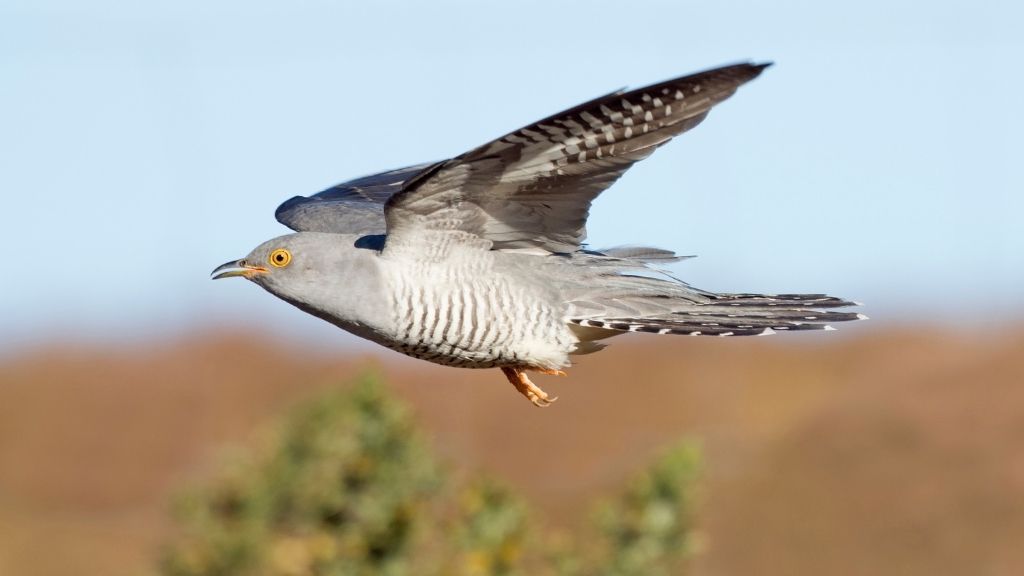Cuckoo bird has crossed the Sahara 10 times in 5 years

A cuckoo bird named PJ just broke an impressive record: He traveled more than 50,000 miles (80,000 kilometers) in the past five years while migrating to and from the U.K.
Common cuckoos (Cuculus canorus) spend their winters in Africa and migrate to the U.K. in the spring to breed, typically arriving in late April and early May, according to the British Trust for Ornithology (BTO). But the familiar birds have become much scarcer in recent decades, with their numbers falling by about 65% in Britain since the early 1980s. In 2009, the species was added to the "red list" of the Royal Society for the Protection of Birds, meaning the birds are of the highest conservation priority in the U.K., The Guardian reported.
To better understand why cuckoo populations are declining, the BTO launched the Cuckoo Tracking Project in 2011 to tag and monitor the birds during their intercontinental migration. The team placed a satellite tag on PJ in 2016, as a part of the tracking project. Since then, they've monitored the cuckoo's travels over the Sahara desert and the Ivory Coast of Africa, through France and Spain, and finally back to Suffolk, England, where he was first found.
Related: 10 amazing things you didn't know about animals
Now, as of April 23, PJ is the first bird in the Cuckoo Tracking Project to complete five migrations back to his English breeding ground, the BTO announced. In the past five years, PJ has crossed the Sahara 10 times, soared through Africa's Atlas Mountains and navigated Europe's Pyrenees, environment correspondent Emily Beament reported for PA Media.
"He is an amazing and unusual cuckoo," Chris Hewson, lead scientist for the Cuckoo Tracking Project, told PA Media. "They normally migrate to Africa via either Spain or Italy and keep to the same route every year, but PJ has used both routes, and one in between, over the five years; and, in fact, last autumn, he stopped in both Spain and Italy." By switching up his route, PJ may have been able to avoid unfavorable conditions along his migration and thus increase his chances of survival, Hewson added.
Hewson and his team previously found that the routes cuckoos take to Africa are associated with different levels of mortality, according to a 2016 report published in the journal Nature Communications. Specifically, birds that fly along the "west route," via Spain and Morocco, appear more likely to die before completing the Sahara crossing compared with birds that take the "east route," via Italy or the Balkans. Most of the deaths on the west route occurred in Europe, hinting that recent droughts, wildfires, large-scale habitat changes and declines in the cuckoo's favorite food, large moth caterpillars, in the region may be to blame.
Sign up for the Live Science daily newsletter now
Get the world’s most fascinating discoveries delivered straight to your inbox.
But despite the many challenges of migration, PJ has made it back to Suffolk once again and is due to turn 6 years old this summer, which will bring him within 11 months of the oldest known cuckoo on British record, according to PA Media.
"We have been avidly watching PJ since he began his journey back to the U.K. in late February, willing him to complete the journey back to the U.K. this spring," Hewson told PA Media. "We can now heave a huge sigh of relief knowing he is safely back in Suffolk, but of course, more than that, I look forward to looking more closely at the information he has given us."
Editor's note: This article has been updated to state that cuckoos breed in the U.K., but do not "nest," as previously stated; they instead lay their eggs in the nests of other birds. The original article was posted on April 26.
Originally published on Live Science.

Nicoletta Lanese is the health channel editor at Live Science and was previously a news editor and staff writer at the site. She holds a graduate certificate in science communication from UC Santa Cruz and degrees in neuroscience and dance from the University of Florida. Her work has appeared in The Scientist, Science News, the Mercury News, Mongabay and Stanford Medicine Magazine, among other outlets. Based in NYC, she also remains heavily involved in dance and performs in local choreographers' work.









